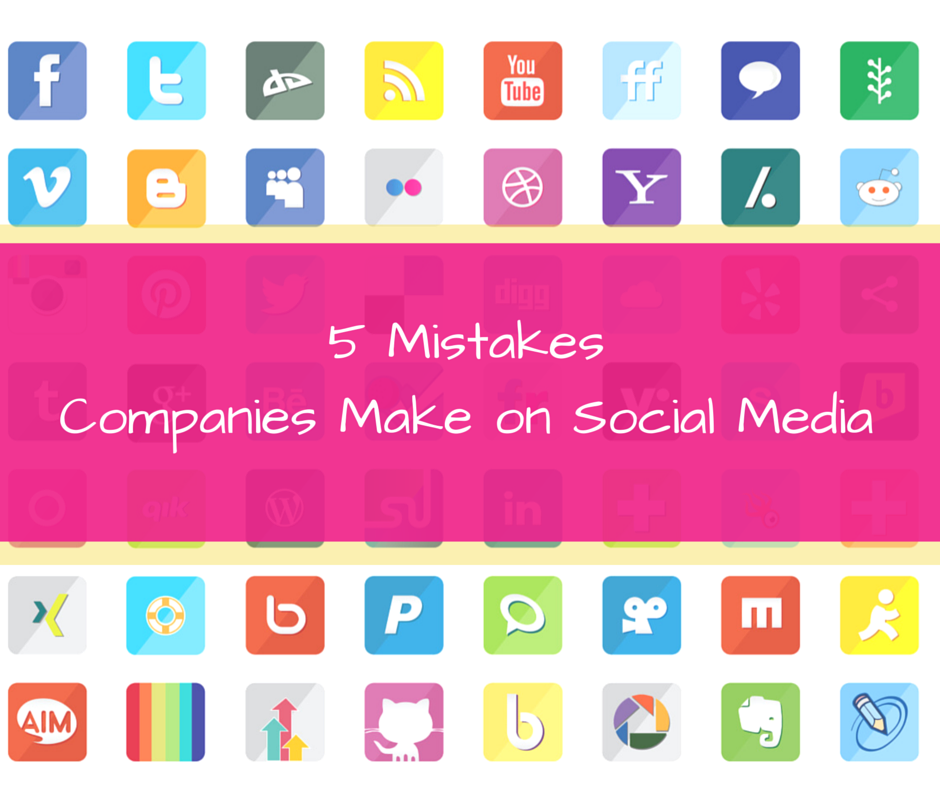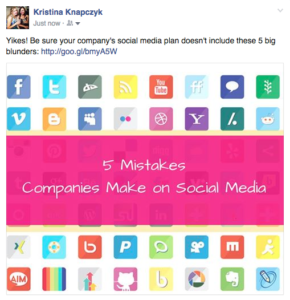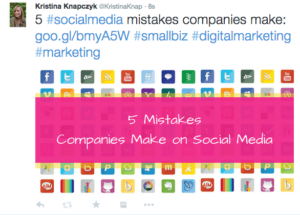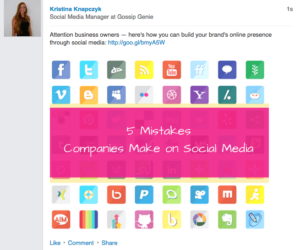In today’s world, it feels like everyone from your old classmates to your hip grandma is on social media. Because of this, more and more companies are following their audience to social platforms by creating their own accounts. However, unless they understand how to use each unique site to its potential, these accounts won’t help their brands in a meaningful way. So in order to help companies learn from the errors of others just like them, I’ve compiled this list of mistakes companies make on social media sites and how to avoid them.
Mistake #1: Posting the same, exact content on every account
Solution #1: Repurpose and optimize similar content for each outlet
I understand: you don’t have time to create original content for each social outlet. Customizing content can be a lengthy process and many small businesses just do not have the resources to do so.
The bad news, though, is that often times what works on Facebook doesn’t resonate well with Instagram users or successful tweets don’t always make successful LinkedIn posts. Why is this the case?
Duplicate content does not have the same impact across all social channels because the demographics are different for each. Therefore, it is critical to create content that matches the interests of each site’s particular audience. To clarify what the demographics are for each social media platform, Sprout Social created this awesome article, complete with graphs and charts, to help out you out.
Don’t worry, there’s good news too! Most of the time you can use the same content but just repurpose it to fit each site. Check out my example below:
Facebook:
Twitter:
LinkedIn:
Notice how each post includes the same image but the text has been altered to intrigue the audience of each site. Pro tip: optimizing your photo size for each site will also help your post reach a wider audience.
Mistake #2: Not understanding the nuances of each site
Solution #2: Do your research
In addition to not understanding the demographics, another mistake companies make is not understanding the tools and characteristics of each either. For instance, LinkedIn does not support hashtags, Instagram is not huge on links, and Snapchat is about immediacy.
There is a simple fix to this issue: do your research! Reading up on how each site thrives is the easiest way to avoid careless mistakes that reveal your lack of knowledge and make you look unprofessional. Google “how to get more Pinterest followers,” create your own account on Google+ to explore, and ask friends why they like Tumblr more than Flickr. These are great ways to discover how you can beef up your social media strategy.
Mistake #3: Posting too much promotional content
Solution #3: Variety is the spice of life!
The quickest way to lose followers is to relentlessly ask them to buy your products or share your post with their friends. Warning: this will not work!
For the average person, social media is a fun and laid back activity to engage in and the last thing people want to see while cuddled up on the couch with a glass of wine waiting for Scandal to start is multiple posts urging them to buy this house or eat at this restaurant.
So, make your account fun! Make your page a destination users want to visit because the content is interesting. Run contests, create fill in the blanks, share quotes, weigh in on sporting events, profile employees, post links — do anything but post the same sales pitch day in and day out. A good rule to follow is the 80/20 rule: 80% of your posts should be intriguing content while 20% should be promotional.
Mistake #4: Ignoring comments and responses from users
Solution #4: Stop ignoring comments and responses from users
Too often, I see brands publish a post and then never look back. Imagine if you finished ringing up a customer’s purchase and then just stopped speaking to them once the transaction was complete, even if they were still talking to you. This is essentially what you’re doing on your social accounts when you don’t reply to comments or timeline posts!
The best way to leave a lasting impact on your fans is to get them involved in your content and make them feel like their contribution matters. So, thank them for their input or start a conversation. Humanize your company and get your fans interested in what you have to offer, without constantly asking for their business.
I know what you’re going to ask: but what about the negative and often rude comments? First and foremost, deleting comments that are incredibly insensitive (i.e. excessive profanity, sexist stereotypes, etc.) is okay. However, deleting comments strictly because a customer is unhappy is not.
Reply to the negative comments as best as you can. Say something along the lines of “We’re sorry to hear about your bad experience. We are fixing the issue now and apologize for the mix-up.” Depending on the severity of the problem, coupons or refunds may need to be issued. The last thing you need is to get bad reviews or lose customers as a result of apathy.
Mistake #5: Not reviewing posted content
Solution #5: Always be conscious of what you’re posting and whether you’re using a business or personal account
Ahhh yes, the queen mother of all social media blunders! For this one, I will let the mistakes of others be your explanation. Yikes!





